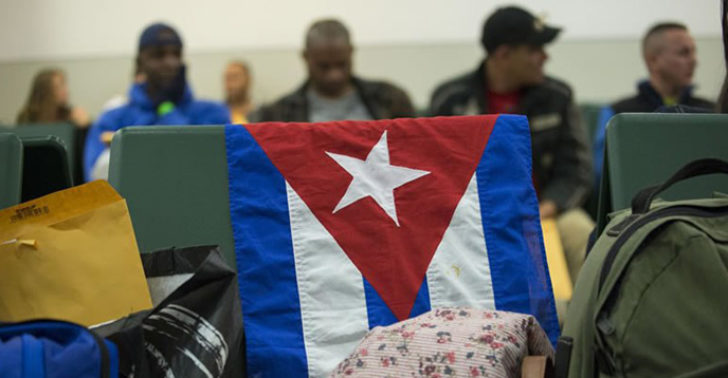
The balance, in hard currency, of the Cuban emigration
HAVANA — His eyes sparkling, Enrique describes to me the face of the old Italian woman to whom he asked in 1993 to sew inside his trousers all the dollar bills he saved in that six-month stay that saved him from neuropathy.
“With my family eating rope and I eating steaks, I had to take a risk,” he says. And I remember that the grandmother of a friend of mine, Catholic and demure, brought her dollars in her panties.”
“If [the Customs people] caught you, they broke your legs,” continues Enrique, and he tells me about that afternoon when the entire neighborhood was astounded to see the bundle of green bills that a boy running from the police had thrown into a dustbin.
Then I remember my mother and my father speaking very softly, my father holding a box of Sue soap bars and telling my mother: “He wanted to pay me with dollars and I told him ‘don’t bother,’ so he gave me these and some chewing gum for the girl.”
The situation had to get worse before the possession of dollars was depenalized in Cuba. As an alternative of survival for the country, in summer of 1993 we were allowed to use that hard currency that baled us out but opened other holes through which water filled the boat.
A sudden ideological change, a desperate move, a unique alternative for some; for others, a light in the darkness of the Special Period.
 “Who could have told us […] — doctrinaires that we were, combating the investments of foreign capital — that we would see it now as an imperative need?” said Fidel Castro in his 26 July speech in Santiago de Cuba in 1993. And then he argued:
“Who could have told us […] — doctrinaires that we were, combating the investments of foreign capital — that we would see it now as an imperative need?” said Fidel Castro in his 26 July speech in Santiago de Cuba in 1993. And then he argued:
“If several thousand families — one thousand, 10 thousand, 100 thousand — can receive a package of food, that doesn’t harm the country,” although he acknowledged that “Oh, well, there will be some who’ll have privileges that the others won’t.” And he justified the remittances: “But the people will receive an appreciable part of that money for their most essential needs.”
Remittances are a phenomenon that has existed since the 19th Century with the increase in migratory trends. In the same way that emigration provides the receptor nations with a labor force, the emigrants provide (almost like a tacit agreement of exchange) a substantial source of revenue for the country of origin.
This is called a functional emigration: the developed countries benefit, and in turn benefit the countries of lesser development through this form of capital income that can become the main Gross Domestic Product.
Worldwide, the regions that produce the most migrants and therefore receive the most remittances are China and India, with approximately 40.5 billion migrants and 55.06 billion dollars a year. According to a report by the Havana Consulting Group, in 2016 Cuba received $3.44 billion from the U.S. alone (the main destination of Cuban emigrants); this amount was 2.7 percent higher than in 2015.
In 2016, more than 80,000 Cubans left the island. More than 50,000 of them went to the United States; about 30,000 naturalized Spaniards entered the U.S. at least a couple of times a year.
A similar number did the same, utilizing the five-year visas granted to them during the process of reconstruction of Cuba-U.S. relations.
We should also mention the new strategies the State used to obtain real money. One of the measures that resulted from the 1993 decision was the implementation of the Hard Currency Stores (known as TRDs) that opened primarily in zones where the reception of remittances was greatest.
Social exchange, the improvement in the lifestyles of remittance receptors and the opportunity to hire others who would clean the house, tend the garden and care for children or sick relatives benefited lower-level employees who received remittances from abroad.
Tourism-industry workers could freely accept tips, and tourism was one of the first sectors where wages were first raised. Stories abound about professionals who shelved their university diplomas and got jobs in hotels as maintenance workers.
The black market substituted the parallel market but in reverse; thus everyone had access to the dollar bill, whose value rose to 150 Cuban pesos.
The flow of cash grew considerably in Cuba. A drastic reduction in consumer goods created such an imbalance that there was a surplus of dollars because there was no food, no clothing, no footwear, no cleaning products; 300 types of medications were unavailable.
Then came the convertible peso (CUC) and all the crises and speculations that accompanied it, including the rate of exchange, because emigrants who arrive in the First World inevitably send some money home to those of us who earn an average of 18 CUC [$18] a month.
And let’s not forget the 200-percent tax levied on imported goods.
Now, let’s talk about our Telecommunications Company. It’s easy to presume that the growth of the mobile telephony market (almost 2 million cell phones in service) is funded mostly by Cubans abroad.
The double recharges and other plans funded “from abroad” provide the nation with hard currency, thanks to those who have FE (Family Abroad). Those who don’t have it are charged 2 or 3 CUC more.
Remittances are a burden on the émigré but they’re a phenomenon linked to the dynamics of emigration. We in Cuba receive hard currency to a degree that shows that the naive differences Fidel used to talk about have gotten out of hand.
Those who are leaving Cuba to help from abroad are young people who would be greatly needed as the rest of the population ages. And though emigration is a universal and historic phenomenon, even beneficial, it has also caused a great deal of pain.
Sandra de los Santos, 24, did not row a raft to migrate to the United States in 2004; she sent herself from the Bahamas to Miami in a DHL box, traveling six hours in a fetal position.
“The fear of bringing those dollars sewed to my trousers never was greater than the fear that my children might take to the sea on a tire raft, as others did from the Malecón,” Enrique says, as he hands me a cup of espresso.
“It’s La Llave brand,” he says. “My daughter sent it to me last week.”
Progreso Weekly authorizes the total or partial reproduction of the articles by our journalists, so long as the original source and author are identified.

